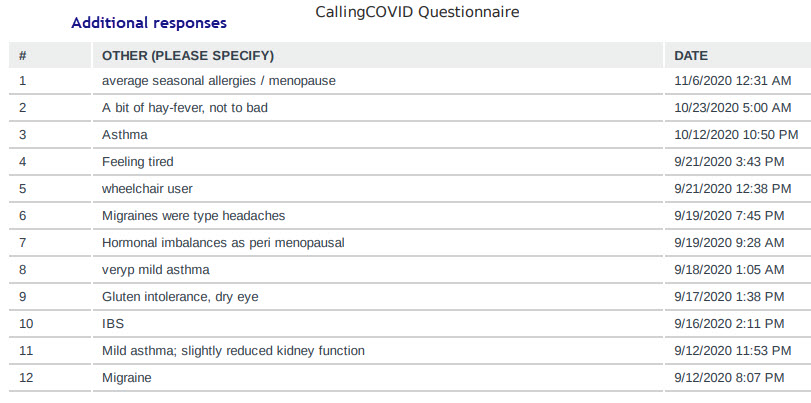Q. 37 - Symptoms commonly experienced BEFORE developing "long-term" COVID-19
LTCOVID.com
Thanks for visiting!
To translate this page, select your
language from the dropdown menu below:
Only 5 skipped this question for symptoms experienced BEFORE developing "long-term" COVID-19.
This list of 58 possible responses for symptoms BEFORE COVID-19, obtained a positive response for 54. In addition, additional symptoms were obtained through the response "Other (please specify," and are shown below.
It was anticipated in the instruction for this question that most possible choices might be negative or unselected.
Clearly, in the aggregate, this was not the case.
For the sample of 132 respondents to this question, the mean number of symptoms is given below :
Headaches, Muscular aches and pains, and cardiovascular problems head the list of what could be called pre-existing conditions before the viral illness began.
"Marked fatigue" was 7th on the list. It returns below as a common symptom of "long-term" COVID-19, early, during and currently in the course of the illness.
Summary: on average, this sample of respondents usually exhibited 4 different symptoms at some point before the start of this viral illness. The duration of these symptoms was not pursued with another question, so remains unknown.
One standard deviation above that mean of 3.8 (in theory capturing 68% of this distribution set), respondents were bothered with 4+5 = 9 different symptoms before their infection with the virus. Clearly this may impose a confounding effect when trying to describe the effects of this illness. In addition, defining a clear endpoint to the viral illness and comparing outcomes is likely to be more difficult.
More on this below at Question 40, which captured the Current Symptoms on the day the survey was taken.
---------
The ideal way of learning about a patient's symptoms when obtaining a medical history is to ask the patient, then listen patiently and attentively to the reply. Eventually, the first responses typically guide the process towards directed questionning which is hopefully fruitful for establishing the diagnosis. It is also more efficient than reading and checking off a "shopping list" of symptoms. Nevertheless, that too appears in a complete Medical History in what is called the Review of Systems, a key part of history taking that helps to avoid overlooking sources of information.
So this long symptom list may be less effective.
But does it prompt a 'yes' response for a given symptom, when that symptom is not being experienced?
Why would that be?
And if he responses returned appear to create a very large list of symptoms, the best thing to do is to accept that this is simply the case, accumulate all that the patient (or respondent sample) has offered, and dismiss nothing. To beginning cutting and cropping the list may be to throw away information vital to eventually understanding an illness that we still know less about than we would like to know.
And as we shall see, why are subgroups of this larger total sample, and that seem to fit together, clearly evident when it comes to numbers and categories of symptoms as presented here?
To aid further, the symptoms have been grouped in other questions into those related to specific organ systems. These were also presented to these patients, and their responses will be provided subsequently and seem to be of use.
But if we stick to this same "shopping list" of symptoms, while accepting its shortcomings, is there an evolution in symptomatology early in the illness, during it's longest period of duration, and at the current time when answering the questionnaire?
We'll pursue that next.
<<<<<<< Previous page
Q. 38 - Symptoms EARLY (during the first 3 to 7 days) of the "long-term" COVID-19 illness >>>>>



